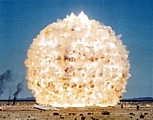 The Defense Threat Reduction Agency announced today that it has canceled the controversial Divine Strake experiment.
The Defense Threat Reduction Agency announced today that it has canceled the controversial Divine Strake experiment.
A 700 tons chemical explosion at the Nevada Test Site was intended to provide data for calibration of nuclear and conventional weapons against underground targets. Local fear that the explosion would kick up and disperse radioactive material from the ground – as well concern about Divine Strake’s role in calibrating the use of low-yield nuclear weapons against underground targets – prompted members of Congress to raise questions about Divine Strake.
The Federation of American Scientists was the first to obtain and publish confirmation from DTRA that Divine Strake was the same experiment described in the FY2006 and FY2007 DTRA budget requests as intended to “improve the warfighter’s confidence in selecting the smallest proper nuclear yield necessary to destroy underground facilities while minimizing collateral damage.” DTRA public affairs officials subsequently denied Divine Strake had any connection to nuclear missions, but were later contradicted by senior DTRA officials saying that it was nuclear related.
Background: Divine Strake
Satellite imagery has long served as a tool for observing on-the-ground activity worldwide, and offers especially valuable insights into the operation, development, and physical features related to nuclear technology.
This report outlines a framework relying on “Cooperative Technical Means” for effective arms control verification based on remote sensing, avoiding on-site inspections but maintaining a level of transparency that allows for immediate detection of changes in nuclear posture or a significant build-up above agreed limits.
The grant comes from the Carnegie Corporation of New York (CCNY) to investigate, alongside The British American Security Information Council (BASIC), the associated impact on nuclear stability.
Satellite imagery of RAF Lakenheath reveals new construction of a security perimeter around ten protective aircraft shelters in the designated nuclear area, the latest measure in a series of upgrades as the base prepares for the ability to store U.S. nuclear weapons.